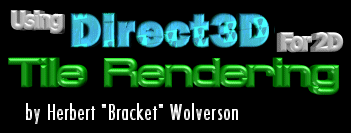11/10 - 11/12 @ Montréal, Canada
12/5 - 12/7 @ Shanghai, China
12/24 - 12/27
2/28 - 3/4 @ San Francisco, CA
More events...
2406 articles in the reference section.
Help us fight cancer!
Join SETI Team GDNet!

|
Where To Go From Here (Or What I didn't cover!)A number of topics could have been in this tutorial, but were omitted so that it didn't turn into a book. The basics of each is here, but a more advanced treatment of any of these would require its own tutorial. Some of these things are:
I'm open to any other suggestions, of course. This tutorial was intended as a primer in using Direct3D to enhance one's tile rendering experience, and I hope it has helped. You can contact me at bracket@unforgettable.com with any questions, comments, queries or complaints! Source CodeDid you start here? I know I would have! Here is the accompanying source code. About The AuthorHerbert Wolverson, commonly known as Bracket, is a 24 year old Computer Consultant. Writing databases (and similar mundane tasks) by day, he works on game technology by night. He somehow also fits in time with Tina, his girlfriend, 2 pet rats, 1 pet snake, a guitar and weekly roleplaying sessions. Bracket needs to sleep more, and drink less caffeine! BibliographyTANSTAAFL, "Isometric 'n' Hexagonal Maps Part I" TANSTAAFL, "Isometric 'n' Hexagonal Maps Part II" Jim Adams, "Isometric Views: Explanation and Interpretation" André LaMothe, Tricks of the Windows Game Programming Gurus. Microsoft, DirectX SDK documentation. Usually the first place to check! |
|||||||||||